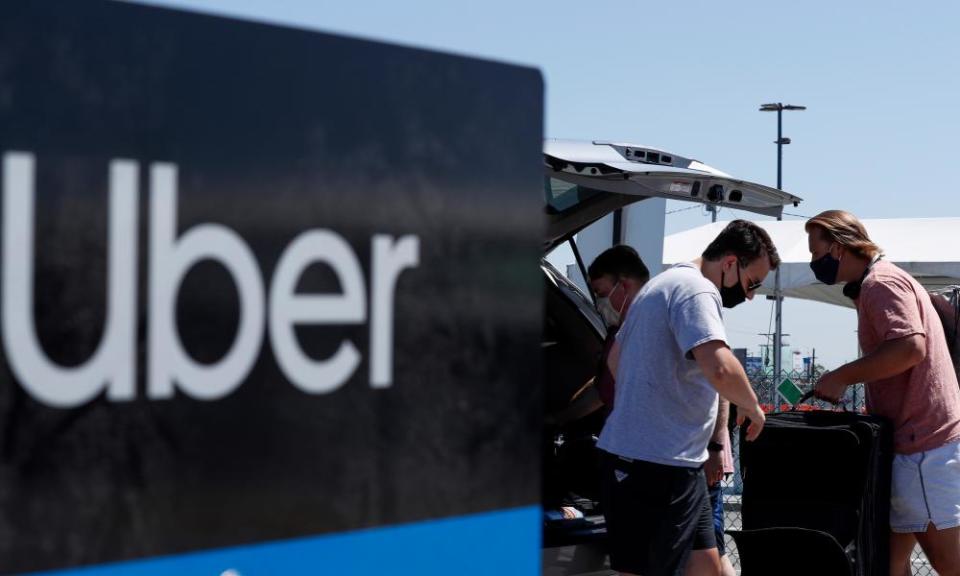Heavy spending on driver incentives pushes Uber to bigger-than-forecast loss

Heavy spending to encourage drivers back to the road has pushed ride-hailing firm Uber into a larger-than-expected loss, despite the company than doubling its revenues as demand for its services increased.
Uber’s “take rate”, or its share of the fare, dropped in the last quarter as it faced elevated costs of getting willing drivers behind the wheel.
The take rate fell to 18.7% in the last quarter, down from 25.8% a year ago, hit by “elevated investments” in reviving driver availability, particularly in the US.
“In Q2 we invested in recovery by investing in drivers and we made strong progress, with monthly active drivers and couriers in the US increasing by nearly 420,000 from February to July,” said Dara Khosrowshahi, the Uber CEO.
Khosrowshahi told investors on an earnings call on Wednesday night that Uber had deployed “good old-fashioned phone calls to folks we haven’t seen in a while” to get drivers back, alongside new digital marketing and more attractive incentives.
He also acknowledged that in big markets such as San Francisco, New York and Los Angeles, demand “continues to outpace supply” and prices and wait times “remain above our comfort level”.
He said Uber is continuing to offer incentives to bring more drivers to the platform. Last week the company announced it would offer free language courses to drivers through a partnership with Rosetta Stone.
“The good news is drivers increasingly want to get back on the road,” said Khosrowshahi, adding that 90% of inactive drivers polled said they expect to come back eventually and 60% say they will come back in the next month.
In April, Uber announced a $250m spending package aimed at encouraging existing drivers to drive for it again, and to attract new recruits.
Some Uber and Lyft drivers have reported that pay rates have not increased in line with higher demand for rides as economies have reopened after Covid-19 lockdowns.
In a sign of confidence, Khosrowshahi reiterated a previous goal that Uber will reach profitability as measured by an adjusted metric known as Ebitda, which excludes taxes and other costs, by the end of 2021.
Under that yardstick – which is closely watched by some investors – Uber’s loss narrowed to $509m during the most recent quarter, down from a loss of $837m at the same time last year, but higher than the $325m loss Wall Street had expected.
Uber’s results also showed it is regaining some of the momentum it lost during the pandemic.
Revenue for the company’s most recent financial quarter doubled year-on-year to $3.93bn, beating analysts’ expectations and signallimg an emergence from the dismal conditions at the same point last year when the pandemic was keeping most people at home.
At the same time, Uber’s delivery service is still growing at an intense pace, indicating that some homebound habits may be here to stay, even though people are going out again.
Related: Uber and Google are latest among tech firms to delay reopening as Delta variant spreads
In an even more telling sign of progress, Uber provided 1.51bn rides during the quarter – an 105% increase from the same time last year. Despite that big jump, the total rides for the period were still roughly 10% below the number given at the same time two years ago, before the pandemic upended the economy.
Uber has invested heavily in delivery services to weather the pandemic. It is increasingly offering grocery delivery and bought alcohol delivery service Drizly in February after acquiring delivery rival Postmates in 2020.
The company’s ride-hailing revenue also more than doubled from last year to $1.62bn.
Earlier this month, drivers in a number of big US cities including Los Angeles and San Francisco joined in a daylong strike protesting poor working conditions and calling for the ability to organise. Some drivers have characterised the record driver shortage, in which drivers are refusing to return, as a “silent strike”.
Uber competitor Lyft announced in its own earnings it had hit that same milestone in the first quarter of 2021, turning a quarterly profit on the adjusted basis for the first time since its founding.
With its lagging profitability and the growing headwinds posed by new surge in coronavirus cases, shares of Uber Technologies fell about 4% in pre-market trading on Thursday..
The Associated Press contributed to this report

 Yahoo Finance
Yahoo Finance 